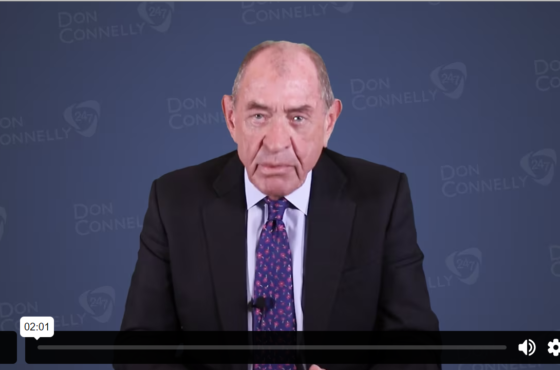Use the Perspective of Time to Move Your Prospects to Action
 Undoubtedly, you are familiar with the theme: You have a prospect in front of you with a clear objective. After gathering all the facts and probing them on why it’s important to them to achieve the goal, you present an iron-clad solution that checks all their boxes, throughout which they nod in agreement. You lay out the steps to get started and ask them for their approval to move forward. When they shift back in their seats, you know what’s coming—the pause, the hesitancy, and the anxiety over making a decision, leading to the standard, “We’d like to think about it.”
Undoubtedly, you are familiar with the theme: You have a prospect in front of you with a clear objective. After gathering all the facts and probing them on why it’s important to them to achieve the goal, you present an iron-clad solution that checks all their boxes, throughout which they nod in agreement. You lay out the steps to get started and ask them for their approval to move forward. When they shift back in their seats, you know what’s coming—the pause, the hesitancy, and the anxiety over making a decision, leading to the standard, “We’d like to think about it.”
After addressing their concerns, walking them through how your solution helps them achieve their objective, once again with approving nods, they again shift in their seats and confide that they just don’t think it’s a good time to start investing.
That’s a very good sign—a strong indication you’ve done your job—up to this point. But your job is not complete until your prospects take action to improve their situation. All they need now is a reassuring nudge. All they might need is some perspective—some time perspective.
Help prospects understand time can be their most valuable asset
When investing for the future, time can be a valuable asset. The more of it you have, the less it costs to achieve your goals. Time is also a wasting asset. With each day that passes, the cost of your dreams goes up. Using time as the context for perspective can be very effective in moving people to action. Here are a few examples of the use of time to change your prospects’ perspective.
#1. Show the market’s performance over time
It’s understandable why some people feel now is not a good time to invest in the stock market. It’s reaching dizzying heights, and recent volatility has been extreme. Help them with their perspective of the market by asking them to write down four dates—their birthdate, the date they graduated from high school, the date of their wedding, and the date their first child was born. Then show them how the DJIA closed on each of those dates.
For example, your prospect is 40 years old:
| Life Event | Date | DJIA Close |
| Prospect’s birthdate | Aug 15, 1980 | 966 |
| High school graduation | Jun 13, 1998 | 8,834 |
| Wedding date | Jun 16, 2007 | 13,346 |
| Current DJIA | May 10, 2021 | 34,742 |
That’s quite a picture of “faith in the future.” Through Middle East wars, the 9/11 terrorist attacks, a global financial crisis, and a global pandemic, the stock market has continued to rise. Fully supported by the evidence of history, optimism is the only valid perspective one can take as they view the future.
#2. Cut prospects’ time horizon down to size
Your prospects want to provide for a college education for their child. You’ve shown them that the annual cost of college today is equivalent to buying a good car each year, and they still balk at starting a plan. Try giving them a new perspective by breaking up their timeline into months. For a three-year-old child, they essentially have 180 months before the bill comes due, and they’ve already wasted 36 months.
If they’re still not convinced, show them the cost of waiting to start a college savings plan.
If you begin saving:
| If you begin saving: | Amount of annual investment needed* |
| Today | $1,728 |
| 3 years from now | $2,211 |
| 5 years from now | $2,648 |
| 10 years from now | $4,543 |
| 15 years from now | $10,341 |
*Assuming a $60,000 need in 20 years with a 5% average annual return
#3. Tell prospects the story of two retirement savers
One way to convince your prospects of the need to start saving now for retirement is to present with a sober reality. For a fortyish prospect, they have just 240 paychecks left until they reach retirement age. If that doesn’t move them, tell them the story of two clients who approached saving for retirement very differently.
There are two people, both age 25. Janet commits to contributing $800 a month – about $10,000 a year to her 401(k) plan. Assuming her 401(k) investment account generates an average annual return of 6 percent, her investment will grow to nearly $360,000 when she turns 45. At that time, she stops working due to health reasons and starts collecting disability insurance. She can no longer contribute to her 401(k) plan.
Her friend, Adam, chooses instead to pursue a better lifestyle and postpones saving until age 45. His rationale for delaying saving is that he would be making more money as his income increased, allowing him to catch up by making larger contributions. With a 20-year time horizon, Adam assumed there would be enough time to build his nest egg. However, his lifestyle and debt commitments only allowed him to contribute $800 a month to his retirement plan. Assuming the same average annual return of 6 percent, Adam’s account value grows to $360,000 – the same amount as Christine’s when she stopped contributing 20 years earlier.
Meanwhile, while Adam was making his 20 years of contributions, Christine’s account continued to grow in value, without any new contributions. By the time they both turned 65, Christine’s account had ballooned to more than $1.1 million. They invested the same amount of money and generated the same rate of return. The big difference is how they utilized their time.
While it’s possible for Adam to catch up with Christine, it would require substantially more significant contributions or taking more risk to generate a higher return on his investments.
The moral of the story is the more time you have, the less it will cost you to achieve your goals. Time can also mitigate risk, enabling you to assume less of it because of the longer period your money is able to work.
Using stories and analogies, and overcoming objections are just few of the skills you’d learn if you join our training program ‘Become Brilliant at the Basics’. Watch this 3-minute video to learn more!
See program details and enroll today!
Available as a self-paced program (always open) or as a 12-week coaching program (open only a few times a year, limited to 25 Advisors at a time).
24 video lessons. 24 exercises. 5 LIVE group coaching sessions (available only with the coaching program). A survivor’s manual and an enormous advantage over your competition. See details and enroll today!



